Effect of Beam Oscillation Amplitude on Microstructure and Mechanical Properties of Small Laser Spot Welded QP980 Steel
Abstract
:1. Introduction
2. Materials and Methods
3. Results and Discussion
3.1. Effect of Oscillation Amplitudes on the Weld Profiles and Laser Energy Distribution
3.2. Effect of Oscillation Amplitudes on the Microstructure and Microhardness of the Welds
3.3. Effect of Oscillation Amplitudes on the Lap Shear Loads
4. Conclusions
- (1)
- The laser energy deposition distribution on the processing surface changed significantly as a function of beam oscillation. As the oscillating amplitude rose, the energy accumulation range enlarged, while the energy peak value was decreased due to the dispersed constant energy of the laser beam. As a result, the appearance of the cross-section transformed gradually from a nail-like shape to a cup-cone-like shape and then to a W-type shape, and the weld depth decreased significantly with the oscillation amplitude.
- (2)
- The FZ and SC-HAZ were full of typical lath martensite, and IC-HAZ was composed of irregular-shaped ferrite and martensite. Beam oscillation could reduce the possibility of pre-existing block martensite decomposing, resulting in the decreasing width of the SZ and the increasing hardness.
- (3)
- Tensile fracture of all welds occurred at the BM, and the tensile strength was close to BM. Thus, the beam oscillation slightly affected weld tensile strength, while the elongation of the joints slightly decreased with the oscillation amplitude due to the wider FZ. The results indicated that beam oscillation could improve the weldability of QP980.
Author Contributions
Funding
Data Availability Statement
Acknowledgments
Conflicts of Interest
References
- Schmitt, J.H.; Iung, T. New developments of advanced high-strength steels for automotive applications. Comptes Rendus Phys. 2018, 19, 641–656. [Google Scholar] [CrossRef]
- Speer, J.; Matlock, D.K.; De Cooman, B.C.; Schroth, J.G. Carbon partitioning into austenite after martensite transformation. Acta Mater. 2003, 51, 2611–2622. [Google Scholar] [CrossRef]
- Zhao, J.W.; Jiang, Z.Y. Thermomechanical processing of advanced high strength steels. Prog. Mater. Sci. 2018, 94, 174–242. [Google Scholar] [CrossRef]
- Ferreira, C.C.A.; Braga, V.; Siqueira, R.H.M.; Carvalho, S.M.; Lima, M.S.F. Laser beam welding of DP980 dual phase steel at high temperatures. Opt. Laser Technol. 2020, 124, 105964. [Google Scholar] [CrossRef]
- Li, Y.; Zhu, Z.H.; Tang, X.H.; Han, S.Y.; Zhang, R.L.; Cui, H.C. Improvement of welding stability and mechanical properties of galvanized DP800 steel lap joint by high-speed tandem beam laser. Opt. Laser Technol. 2022, 150, 107958. [Google Scholar] [CrossRef]
- Di, H.S.; Sun, Q.; Wang, X.N.; Li, J.P. Microstructure and properties in dissimilar/similar weld joints between DP780 and DP980 steels processed by fiber laser welding. J. Mate. Sci. Technol. 2017, 33, 1561–1571. [Google Scholar] [CrossRef]
- Wang, X.N.; Sun, Q.; Zheng, Z.; Di, H.S. Microstructure and fracture behavior of laser welded joints of DP steels with different heat inputs. Mater. Sci. Eng. A 2017, 699, 18–25. [Google Scholar] [CrossRef]
- Alvesa, P.H.O.M.; Limab, M.S.F.; Raabec, D.; Sandima, H.R.Z. Laser beam welding of dual-phase DP1000 steel. J. Mater. Process. Technol. 2018, 252, 498–510. [Google Scholar] [CrossRef]
- Rossini, M.; Spena, P.R.; Cortese, L.; Matteis, P.; Firrao, D. Investigation on dissimilar laser welding of advanced high strength steel sheets for the automotive industry. Mater. Sci. Eng. A 2015, 628, 288–296. [Google Scholar] [CrossRef]
- Razmpoosh, M.H.; Macwan, A.; Biro, E.; Zhou, Y. Microstructure and dynamic tensile characteristics of dissimilar fiber laser welded advanced high strength steels. Mater. Sci. Eng. A 2020, 773, 138729. [Google Scholar] [CrossRef]
- Guo, W.; Wan, Z.D.; Peng, P.; Jia, Q.; Zou, G.S.; Peng, Y. Microstructure and mechanical properties of fiber laser welded QP980 steel. J. Mater. Process. Technol. 2018, 256, 229–238. [Google Scholar] [CrossRef]
- Li, W.D.; Ma, L.X.; Peng, P.; Jia, Q.; Wan, Z.D.; Guo, W. Microstructural evolution and deformation behavior of fiber laser welded QP980 steel joint. Mater. Sci. Eng. A 2018, 717, 124–133. [Google Scholar] [CrossRef]
- Xue, J.L.; Guo, W.; Zhang, Y.X.; Xia, M.S.; Jia, Q.; Chi, J.X.; Shi, J.X.; Wu, Y.; Zhang, H.Q. Local microstructure and mechanical characteristics of HAZ and tensile behavior of laser welded QP980 joints. Mater. Sci. Eng. A 2022, 854, 143862. [Google Scholar]
- Zhao, H.Y.; Huang, R.R.; Sun, Y.M.; Tan, C.W.; Wu, L.J.; Chen, B.; Song, X.G.; Li, G.X. Microstructure and mechanical properties of fiber laser welded QP980/press-hardened 22MnB5 steel joint. J. Mater. Res. Technol. 2020, 9, 10079–10090. [Google Scholar] [CrossRef]
- Guo, W.; Wan, Z.D.; Jia, Q.; Ma, L.X.; Zhang, H.Q.; Tan, C.W.; Peng, P. Laser weldability of TWIP980 with DP980/B1500HS/QP980 steels: Microstructure and mechanical properties. Opt. Laser Technol. 2020, 124, 105961. [Google Scholar] [CrossRef]
- Li, J.Z.; Sun, Q.J.; Liu, Y.B.; Zheng, Z.Y.; Sun, Q.; Feng, J.C. Melt flow and microstructural characteristics in beam oscillation superimposed laser welding of 304 stainless steel. J. Manuf. Process. 2020, 50, 629–637. [Google Scholar] [CrossRef]
- Aalderink, B.J.; Pathiraj, B.; Aarts, R.G.K.M. Seam gap bridging of laser based processes for the welding of aluminium sheets for industrial applications. Int. J. Adv. Manuf. Technol. 2010, 48, 143–154. [Google Scholar] [CrossRef]
- Chen, L.; Mi, G.Y.; Zhang, X.; Wang, C.M. Comparative investigation on single laser beam and dual laser beam for lap welding of aluminum alloy. J. Laser Appl. 2020, 32, 42012. [Google Scholar]
- Liu, B.W.; Jin, W.T.; Lu, A.J.; Liu, K.; Wang, C.M.; Mi, G.Y. Optimal design for dual laser beam butt welding process parameter using artificial neural networks and genetic algorithm for SUS316L austenitic stainless steel. Opt. Laser. Technol. 2020, 125, 106027. [Google Scholar]
- Müller, A.; Goecke, S.F.; Rethmeier, M. Laser beam oscillation welding for automotive applications. Weld. World. 2018, 62, 1039–1047. [Google Scholar] [CrossRef]
- Shah, L.H.; Khodabakhshi, F.; Gerlich, A. Effect of beam wobbling on laser welding of aluminum and magnesium alloy with nickel interlayer. J. Manuf. Process. 2019, 37, 212–219. [Google Scholar] [CrossRef]
- Hao, K.D.; Gao, M.; Wu, R.; Zeng, X.Y. Effect of oscillating laser beam offset on the microstructure and mechanical properties of dissimilar stainless steels joints. J. Mater. Process. Technol. 2020, 275, 116330. [Google Scholar] [CrossRef]
- Hu, K.; Muneer, Q.; Zhang, J.H.; Zhan, X.H. Effect of beam oscillating frequency on the microstructure and mechanical properties of dissimilar laser welding of AA2060 and AA6061 alloy. Mater. Sci. Eng. A 2022, 832, 142431. [Google Scholar] [CrossRef]
- Hao, K.D.; Wang, H.K.; Gao, M.; Wu, R.; Zeng, X.Y. Laser welding of AZ31B magnesium alloy with beam oscillation. J. Mate. Res. Technol. 2019, 8, 3044–3053. [Google Scholar] [CrossRef]
- Jiang, Z.G.; Chen, X.; Li, H.; Lei, Z.L.; Chen, Y.B.; Wu, S.B.; Wang, Y.H. Grain refinement and laser energy distribution during laser oscillating welding of Invar alloy. Mater. Des. 2020, 186, 108195. [Google Scholar] [CrossRef]
- Fetzer, F.; Sommer, M.; Weber, R.; Weberpals, J.P.; Graf, T. Reduction of pores by means of laser beam oscillation during remote welding of AlMgSi. Opt. Laser. Eng. 2018, 108, 68–77. [Google Scholar] [CrossRef]
- Zhang, C.; Yu, Y.; Chen, C.; Zeng, X.Y.; Gao, M. Suppressing porosity of a laser keyhole welded Al-6Mg alloy via beam oscillation. J. Mater. Process. Technol. 2020, 278, 116382. [Google Scholar]
- Rai, R.; Kelly, S.M.; Martukanitz, R.P.; Debroy, T. A convective heat-transfer model for partial and full penetration keyhole mode laser welding of a structural steel. Metall. Mater. Trans. A 2008, 39, 98–112. [Google Scholar]
- Wang, X.N.; Chen, C.J.; Wang, H.S.; Zhang, S.H.; Zhang, M.; Luo, X. Microstructure formation and precipitation in laser welding of microalloyed C-Mn steel. J. Mater. Process. Technol. 2015, 226, 106–114. [Google Scholar]
- Gould, J.E.; Khurana, S.P.; Li, T. Predictions of microstructures when welding automotive advanced high-strength steels. Weld. J. 2006, 85, 111. [Google Scholar]
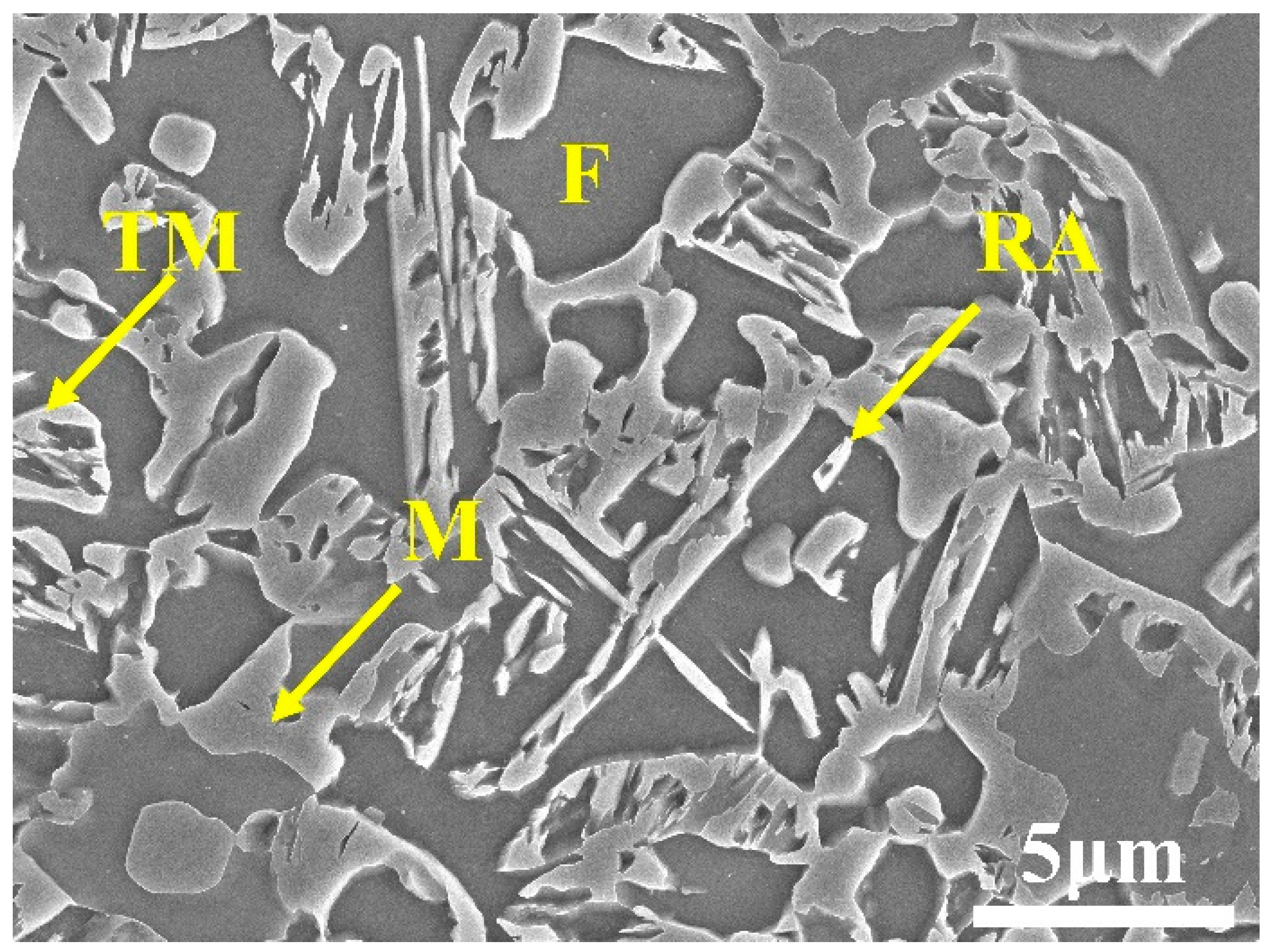
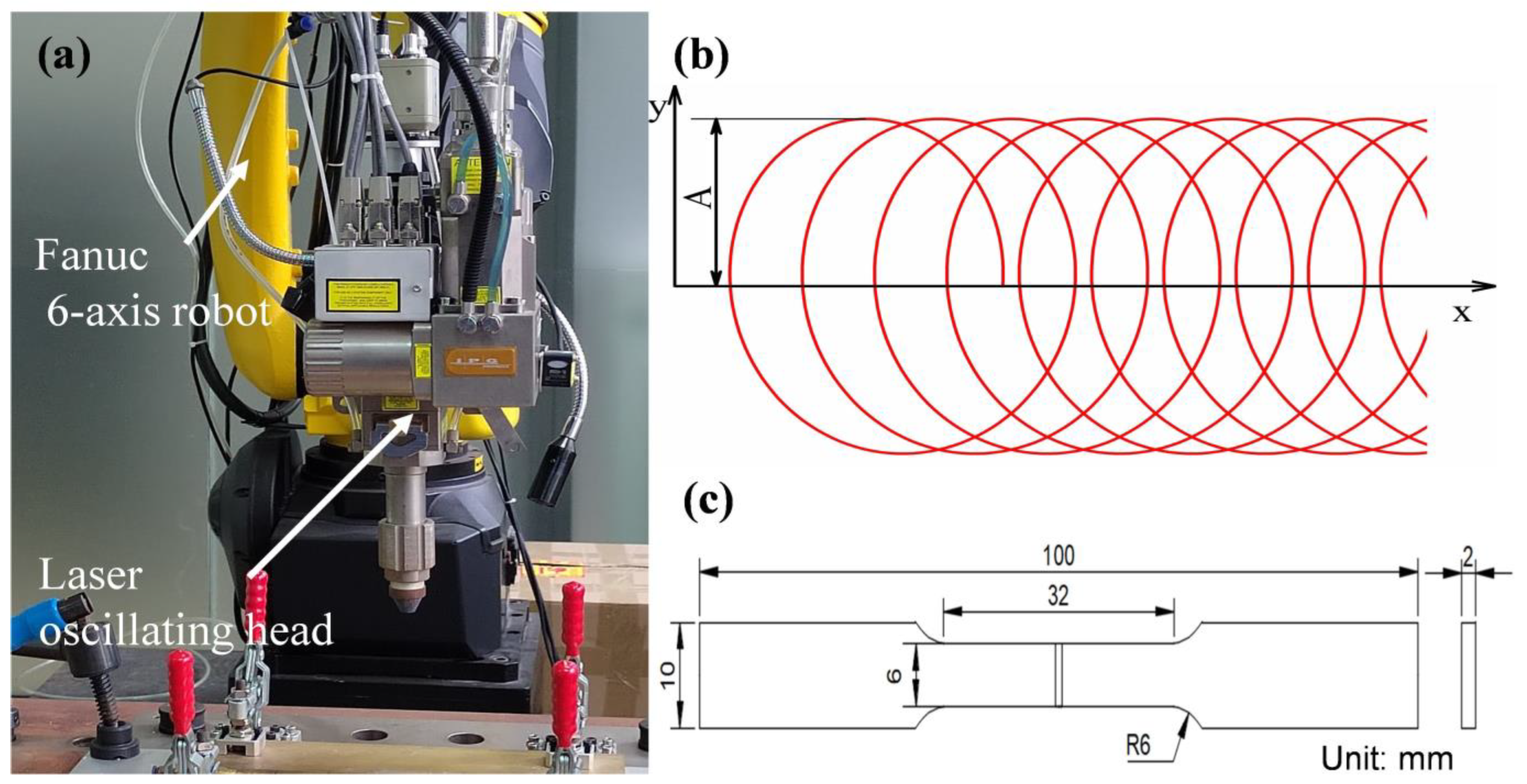
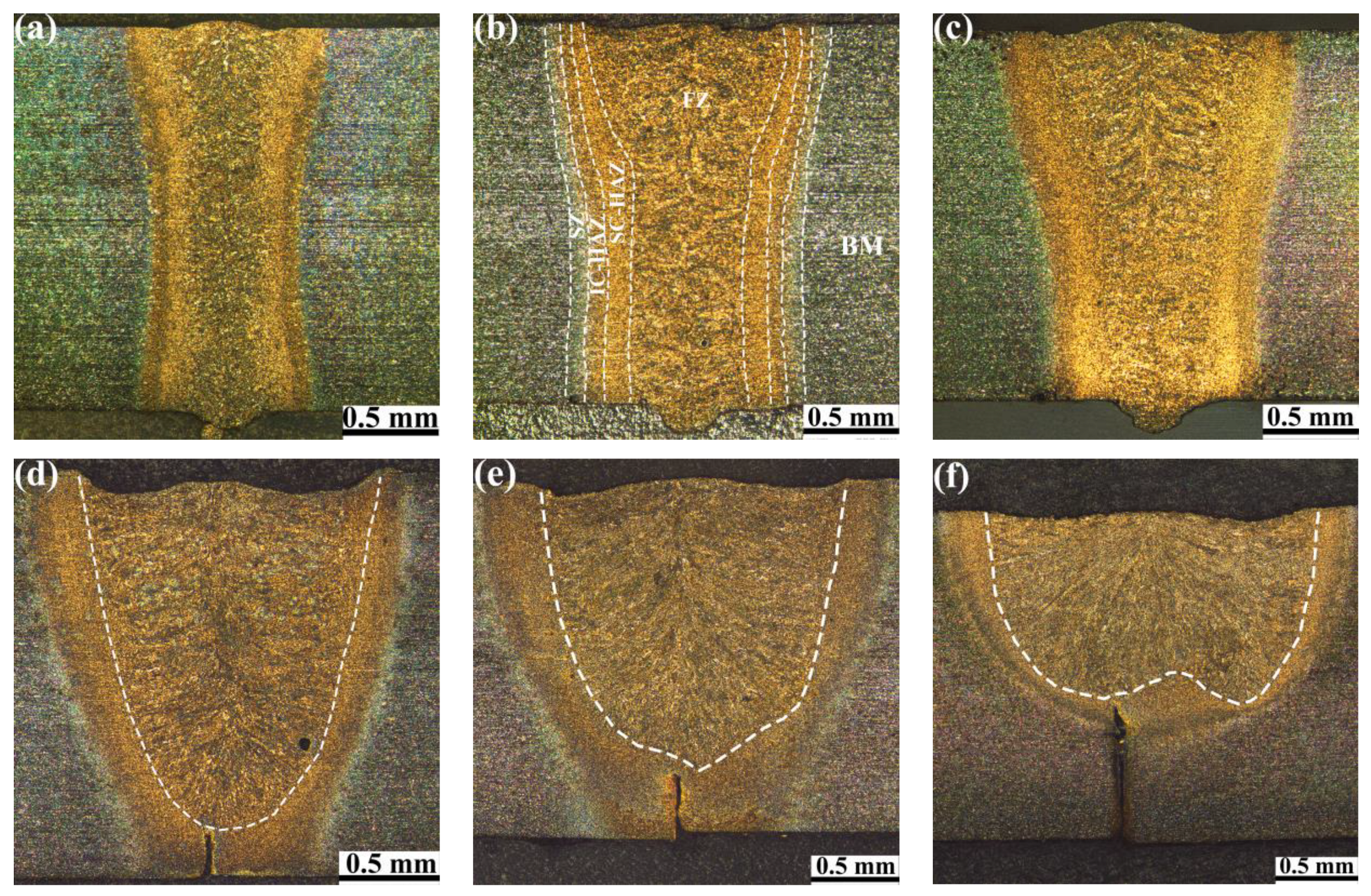
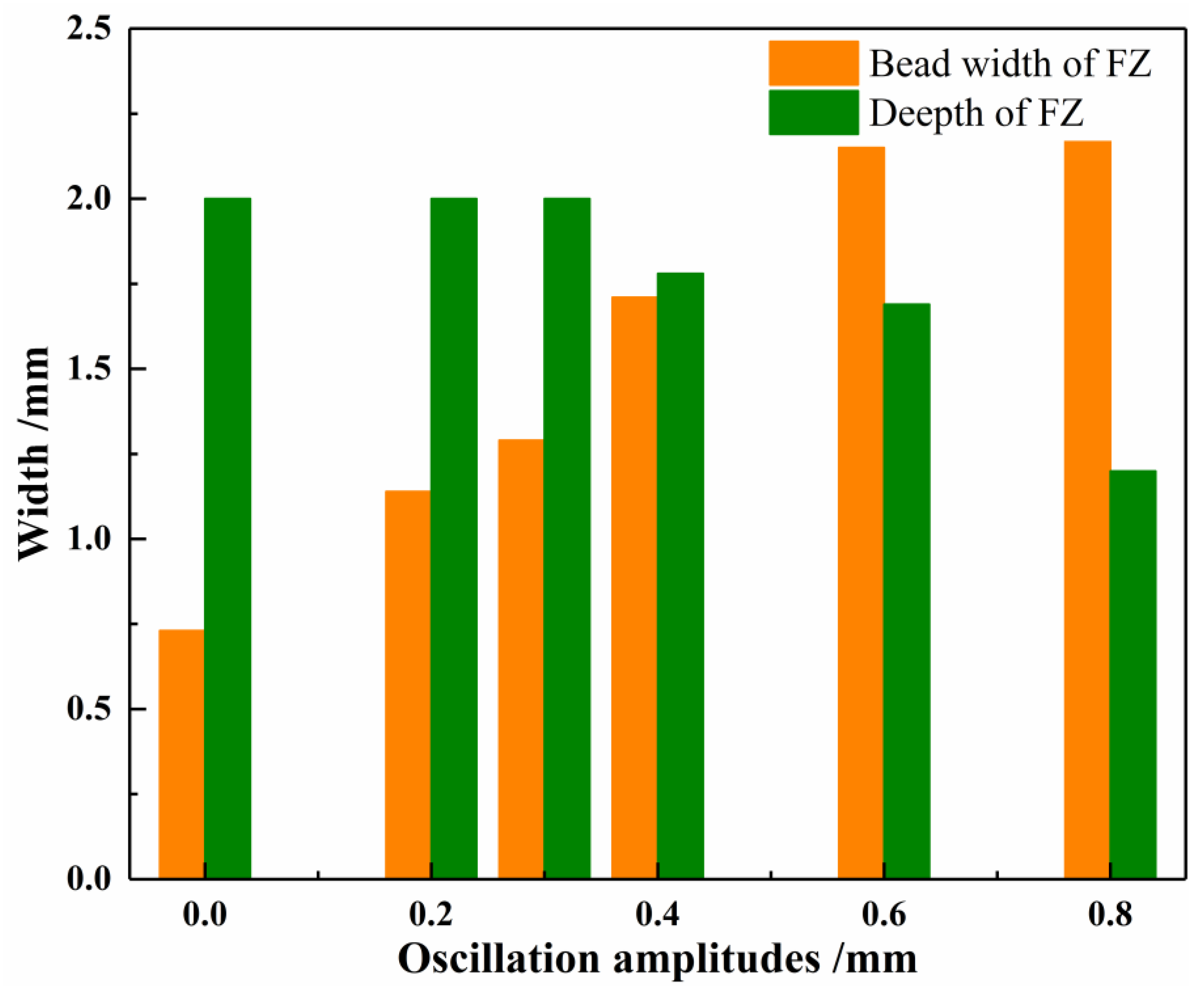
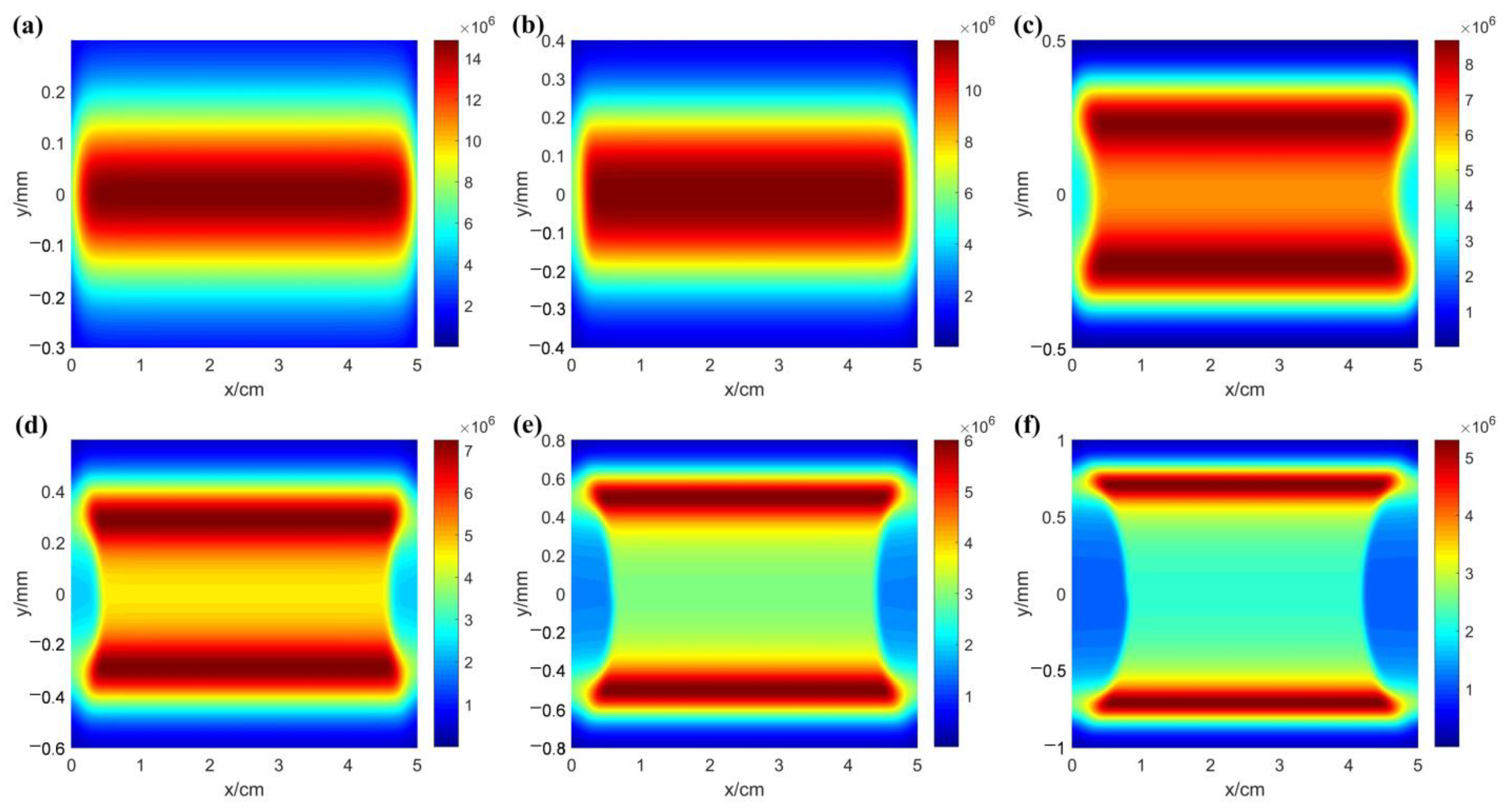

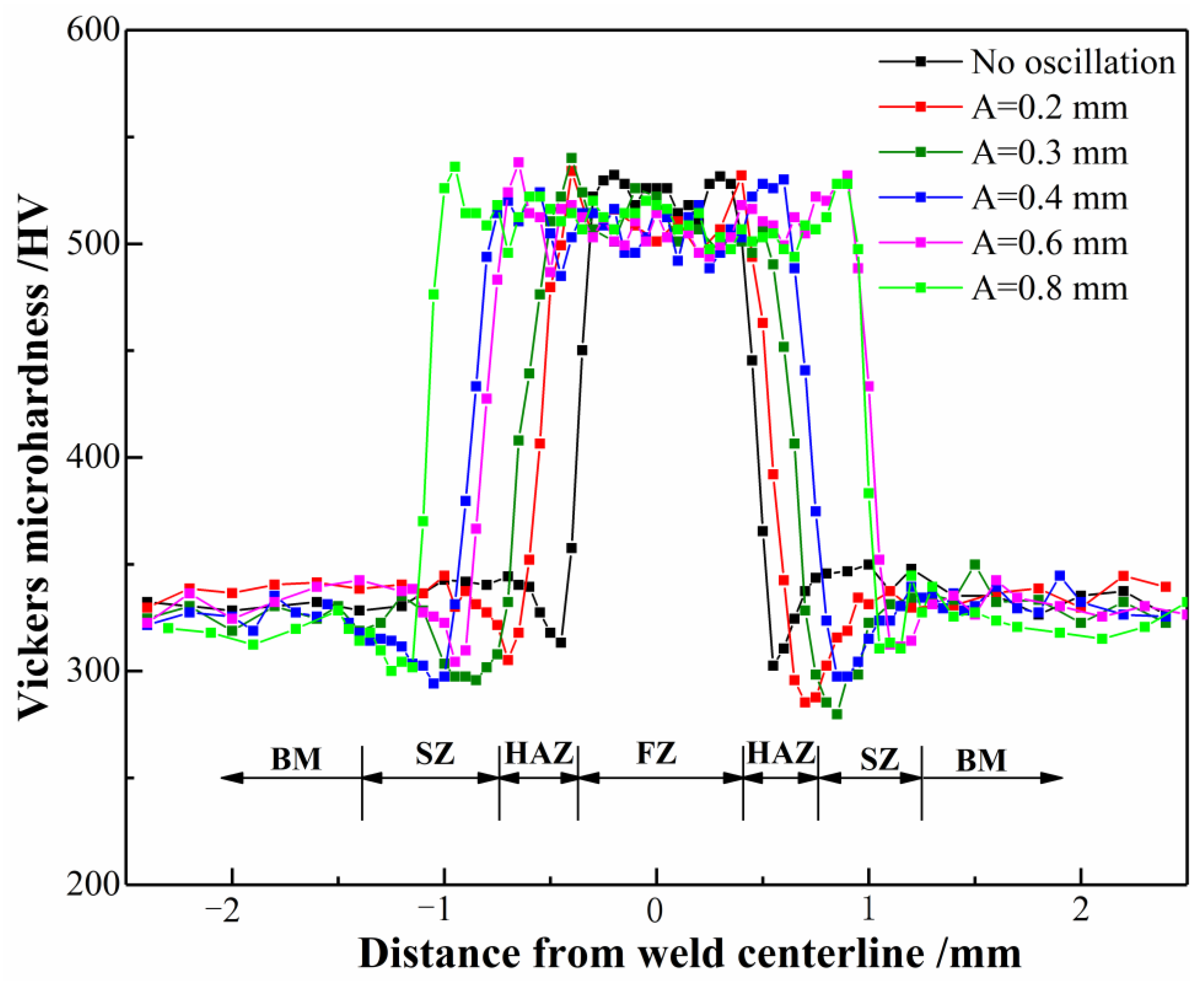
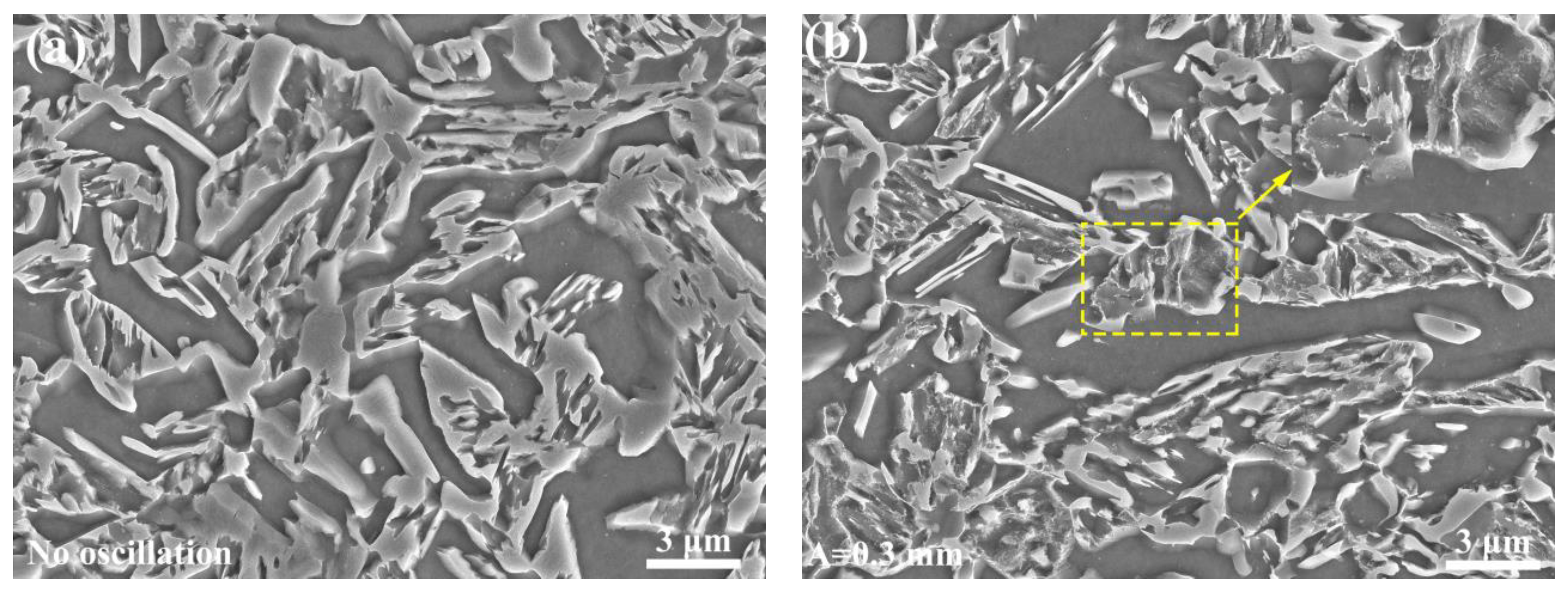
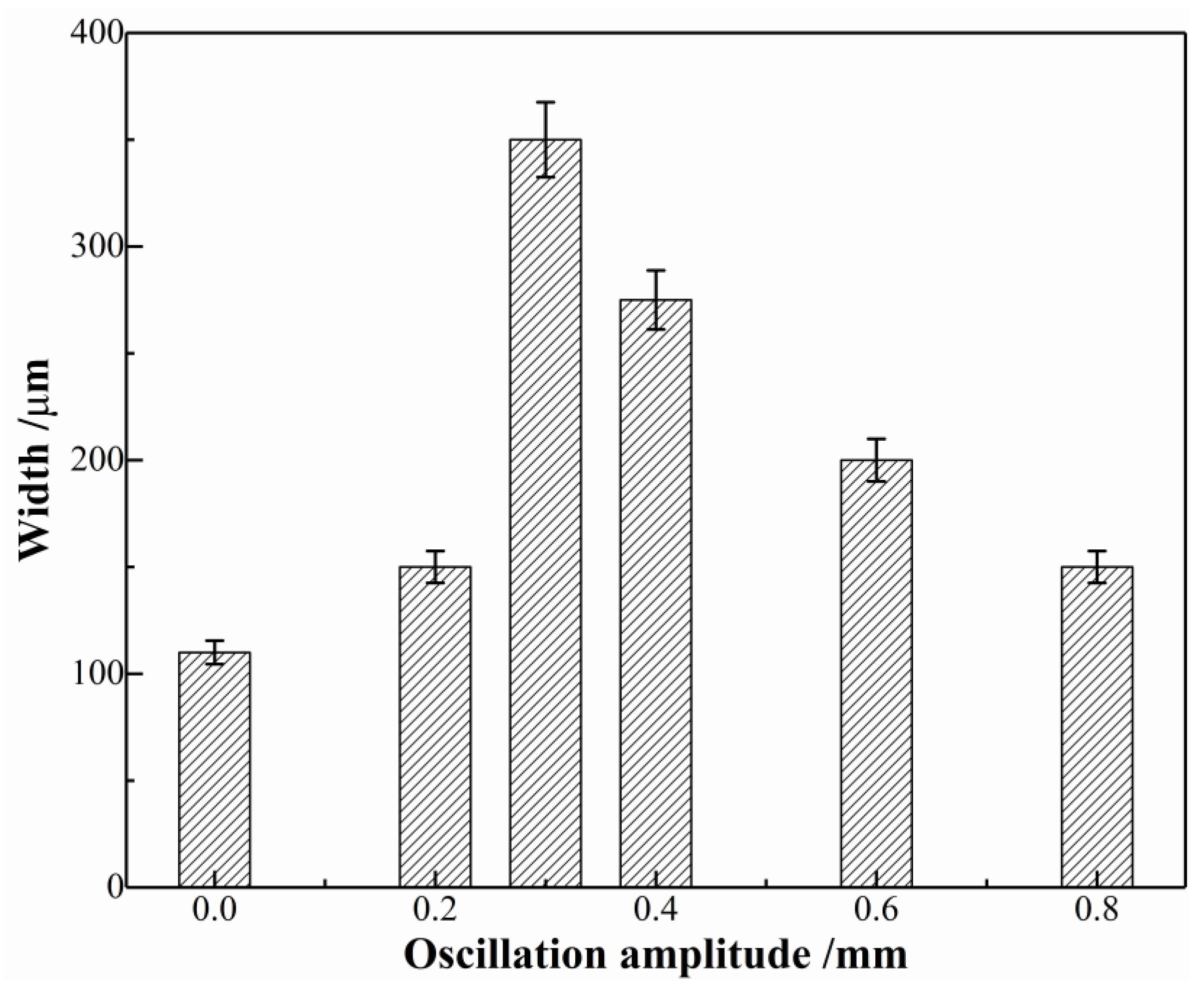
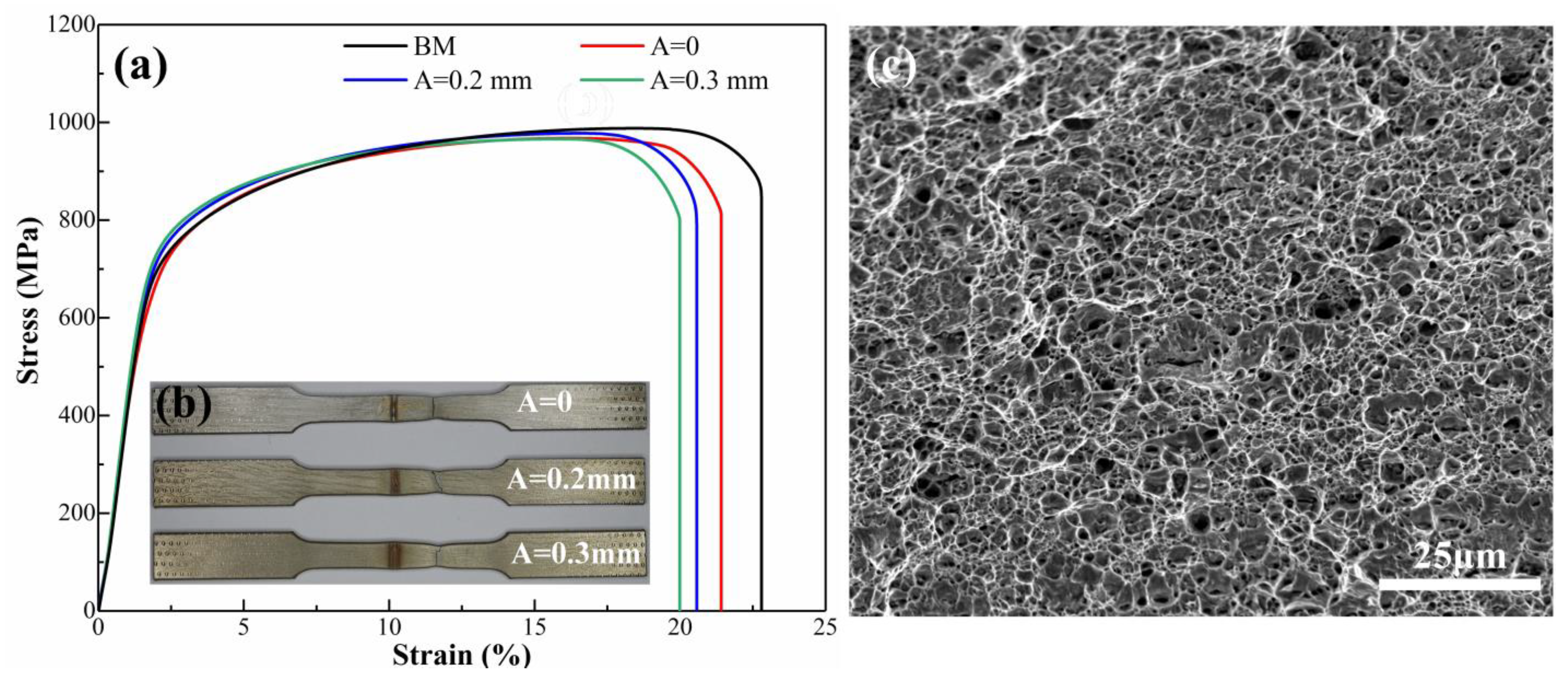
| C | Si | Mn | P | Al | Fe | Y.S.(MPa) | T.S. (MPa) | Elongation (%) |
|---|---|---|---|---|---|---|---|---|
| 0.18 | 1.75 | 2.26 | 0.012 | 0.026 | Bal. | 686 | 1050 | 22 |
| Process Parameters | Values |
|---|---|
| Laser power (kW) | 1.4 |
| Welding speed (cm/s) | 5 |
| Oscillating frequency (Hz) | 0, 150 |
| Oscillating amplitude (mm) | 0, 0.2, 0.3, 0.4, 0.6, 0.8 |
| Oscillation Amplitudes | Yield Strength (MPa) | Tensile Strength (MPa) | Elongation (%) |
|---|---|---|---|
| BM | 668 | 998 | 22.8 |
| no oscillation | 665 | 962 | 21.4 |
| 0.2 mm | 663 | 978 | 20.6 |
| 0.3 mm | 668 | 966 | 20 |
Disclaimer/Publisher’s Note: The statements, opinions and data contained in all publications are solely those of the individual author(s) and contributor(s) and not of MDPI and/or the editor(s). MDPI and/or the editor(s) disclaim responsibility for any injury to people or property resulting from any ideas, methods, instructions or products referred to in the content. |
© 2023 by the authors. Licensee MDPI, Basel, Switzerland. This article is an open access article distributed under the terms and conditions of the Creative Commons Attribution (CC BY) license (https://creativecommons.org/licenses/by/4.0/).
Share and Cite
Yang, J.; Li, T.; Ye, W.; Chen, J.; Qiao, J. Effect of Beam Oscillation Amplitude on Microstructure and Mechanical Properties of Small Laser Spot Welded QP980 Steel. Metals 2023, 13, 1363. https://doi.org/10.3390/met13081363
Yang J, Li T, Ye W, Chen J, Qiao J. Effect of Beam Oscillation Amplitude on Microstructure and Mechanical Properties of Small Laser Spot Welded QP980 Steel. Metals. 2023; 13(8):1363. https://doi.org/10.3390/met13081363
Chicago/Turabian StyleYang, Jingwei, Tao Li, Wolin Ye, Jiale Chen, and Jian Qiao. 2023. "Effect of Beam Oscillation Amplitude on Microstructure and Mechanical Properties of Small Laser Spot Welded QP980 Steel" Metals 13, no. 8: 1363. https://doi.org/10.3390/met13081363
APA StyleYang, J., Li, T., Ye, W., Chen, J., & Qiao, J. (2023). Effect of Beam Oscillation Amplitude on Microstructure and Mechanical Properties of Small Laser Spot Welded QP980 Steel. Metals, 13(8), 1363. https://doi.org/10.3390/met13081363






